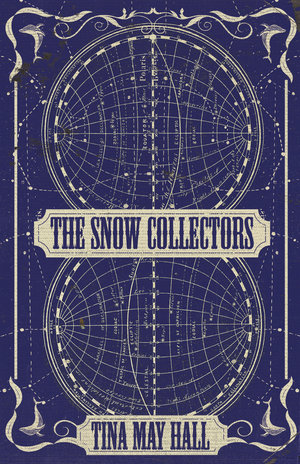Reviewed by Sierra Napoleon

Henna, trying to escape the disappearance of her parents and twin sister Claire at sea, retreats north to a village (not a town) where the snow almost never stops. Here, Henna attracts things. Dust. Smooth stones. Paper scraps. Tributaries. Trouble. Lady Jane Franklin. Someone. A dead woman’s body on the edge of her property. She spends her days typing encyclopedia notes at her typewriter, her sister’s basset hound Rembrandt at her side, swirling in a fascination, a connection even, with water and ice and Arctic expeditions and memories of her family. All the while, the earth around her continues its slippery slope into environmental collapse as the Midwest dries into deserts, as the bees get declared extinct, and as snow, prevalent as it is within Henna’s world, becomes a rarity for most children.
In her newest fiction novel, The Snow Collectors, established author Tina May Hall presents this world and Henna’s story to us as a multitude of genres packed into fairly short chapters broken into even smaller sections. It is primarily a Gothic murder mystery, tinged with science fiction and romance and history. This unfolding mystery is spliced up with small pieces of a more complicated past and begs us to question its small cast of characters and all their eccentricities, especially those within our main character. It makes us want to understand their place within this story spanning centuries as well as the Atlantic. It makes us see a setting filled with bleak landscapes of monochrome dotted with outfits that could rival the Joker’s and bathrooms that look like gaping wounds. It sets before us twists and turns, both in the mystery and in the landscape and Victorian buildings of this permanent winter wonderland, as we question what the title truly implies with “snow collectors.”
As stated previously, this story focuses on Henna, the reclusive new arrival in a northeastern village. Before her family disappeared at sea, she was the odd one in the family, not partaking in painting or sculpting but rather encyclopedia edits. Now, she studies the Arctic expedition collection in the library tower, buys sourdough bread at the bakery for her sister’s dog, and finds friendship with the mute lady who communicates with silver ink and tends to genetically engineered bees. Her orderly life far away from the haunting ocean, however, gets dismantled when she gets entangled in the strange death of a young woman found at the edge of her property. With her body quickly taken away, Henna’s search for answers begins with a scrap of an old letter found clutched in the woman’s hand, signed off by a Jane. From here, we immerse further into the characters. A trio of toothless old men clad in caps. A librarian/bartender with a white curled mustache. A golden police chief teeming with affectionate hand touches. A hermit on the hill far from his ship. A prim and proper lady with carnivorous birds. A man lost in the Arctic and his impatient wife scribbling letters. A someone always lurking in the shadows, the night. This story, gently traced through several buildings and houses in the village, is generally told through Henna’s point of view in painfully beautiful details of shiny snow, foggy glass, spicy honey, heavy heat, humming water, and the intricate blending of wood and metal. However, we are also treated to slices of third person that briefly paint stories of the traumas and controversies surrounding Sir John Franklin and Lady Jane Franklin, both actual historical figures, as well as the snow collectors and their charts and labeled vials of water.
I read this book quite quickly, in less than two days. As someone who struggles with reading, I found it easy to read, even if I had to do it all aloud. This was probably because the book is written in a very nice moderately sized font. It is also probably because I was enthralled in its gorgeous sentences that bled life into everything Henna encountered. Desperate to confirm my suspicions regarding the mystery, the controversy. Feeling some sense of connection to the characters’ freezing plight as I sat bundled in blankets reading on my laptop, observing the frost on the grass outside the kitchen windows, bathed in a hazy blue chill. It also presented things I have not seen in other works regarding murder mysteries. For example, the blending of actual historical people and events into a story otherwise completely fictional, making that always important statement of something being a “work of fiction” really necessary. The genres of the story tend to be ones commonly combined, but “sci-fi murder mystery” is not really a phrase I have seen used often. The best contemporary example I can think of is not even a novel; it is that popular multiplayer game Among Us. It also gives us a different form of sidekick in the snuffling, food-driven dog that is Rembrandt, who proves useful on several occasions but is mostly seen eating bones and destroying furniture. Overall, The Snow Collectors is a twisted, tangled web full of pretty droplets of words that breathlessly push you towards finding the spider at the middle of it all.
